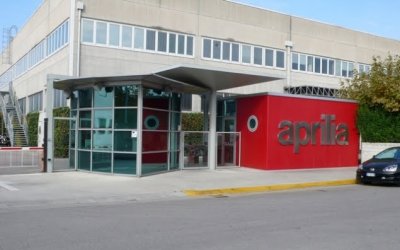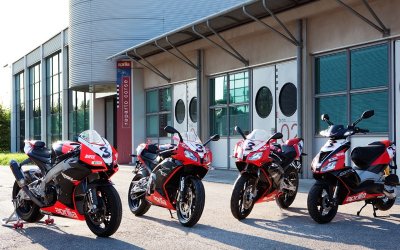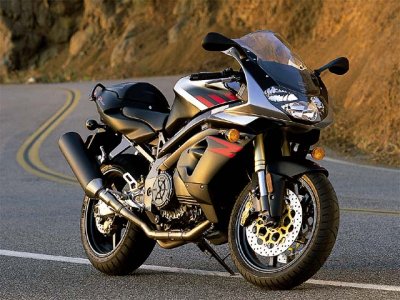Cavalier Alberto Beggio founded the Aprilia company immediately after the Second World War, the company began producing bicycles in the small town of Noale which is in the province of Venice. When Cavalier asked his son Ivano to join the company in 1968, the focus quickly turned from bicycles to motorcycles.
The first Aprilia motorcycle was built by Ivano and 12 assistants from the factory in 1968, the bike featured a blue and gold colour scheme and contained a 50cc engine. In 1968 Aprilia set about producing two mopeds which they affectionately called the Colibrì and Daniela, both mopeds were well received by the public, however it was the 1970 Scarabeo Cross Motorcycle that made Aprilia famous. The Scarabeo, became a true passion for those who dreamed of competing in national competitions, in a discipline that was fast becoming extremely popular. The Scarabeo was produced in various capacities from 50cc – 125cc, and all models featured a truly unique and innovative design. The Scarabeo remained in production until the mid 1970's.
The first true motocross bike was born in 1974, and was handed over for testing to Maurizio Sgarzani, the test results were encouraging and at this stage Aprilia technicians began developing a RC125 which combined both technology and sports.
Father and son understood that in order to further promote their product in a world that was without the marketing campaigns of today, they must place their motorcycles on the race track and win. In 1975 Aprilia began racing the RC125 nationally with Ivan Alborghetti who obtained successful results in the first year however, the 1st Italian Championship arrived in 1977 in both the 125cc and 250cc class and Aprilia's success was met open arms, and so began Italy's love affair with Aprilia motorcycles.
It was not long until the Aprilia fame began to spread throughout Europe and over oceans, Aprilia saw the opportunity to begin exporting their motorcycles throughout the world, the greatest export market became America. The decade ended with a constant growth in production, which was divided between mopeds and motocross bikes. Aprilia's Moped production grew from 150 units to 12,000 units from 1969 – 1979 whilst their motorcycle production increased to 2,000 units per year in just a four year period.

The beginning of the Eighties saw a financial crisis impact the world, during this time Aprilia laid the foundation for future projects and developed new strategies, with the idea that the market would eventually recover. Aprilia decided to further develop their range to include enduro motorcycles, trials motorcycles and road motorcycles with engine sizes ranging from 50 to 600 cc.
The fruits of Aprilia's labor over those tough years was seen when they released their first road motorcycle the ST 125 in 1983. The ST 125 was an instant success especially within the press. The following year Aprilia produced the STX an improved and more sporting version of the ST. Aprilia first enduro motorcycle was produced around the same time with a small 50cc engine which had been developed from Aprilia's racing efforts in the motocross discipline. In 1985 Aprilia launched the ETX in both 125cc and 350cc capacities, these motorcycles were aimed at the motocross market, however over the next few years the motocross market's popularity began to decrease and as a result it became extremely specialized, Aprilia decided at that point to focus on growing their road and endurance market.
In 1986 Aprilia developed the road going AF1 whilst in the endurance range the ETX was joined by the Tuareg. Tuareg had been inspired by the motorcycles used in the African rallies which were hugely popular in the mid-eighties, the bike incorporated a large tank and a range of accessories.
Aprilia prided themselves on the fact that their motorcycles contained the latest in technology, but it also came to their attention that their bikes could also be distinguished by their design and graphic styles, which was different from the usual bland monotone colours of the motorcycle world. Aprilia began to believe that with their unique ability to create modern designs they could create emotions and so open the world of motorcycles to a younger audience. Aprilia explored this idea with the EXT by using two tone colours, however it was not until the late Eighties that Aprilia took this insight to a new level and designed the colour scheme of the AF1 in pastel tones the like of which had never been seen in the sportbike category.

After Aprilia's first race experience in the trials discipline in 1981, they decided to compete in a whole season of the Trials World Championship in 1985 – the result was a 5th place overall for rider Philippe Berlatier. That same year Aprilia decided to also compete in the 250cc class of the World Road Racing Championship, with Loris Reggiani. It was a challenge considered rash by many observers, that a small Italian factory without any road racing experience, would go onto the track and take on the powerful Japanese, however, at the end of the first season the Aprilia GP 250 finished 6th in the World Championship standings. The Noale company's first victory arrived two years later when at the Grand Prix of San Marino, Loris Reggiani would take the Aprilia AF1 onto the top step of the podium.
With the success of the road racing efforts, Aprilia's overall strategy changed and they began developing motorcycles of competition quality, technology and of course style. Aprilia's success in the road racing championships did not result in off-road bikes being abandoned, 1990 was the year of the Pegaso 600. The Pegaso went onto revolutionise the sector, with its off-road origins designed for on-road use.
In 1992 Aprilia received its 1st World Championship in the 125cc class with a bike that was still in development, the Championship was won by Alessandro Gramigni and it would be followed by the Tommy Ahvala claiming the Trials World Championship the same year.
Right from the start, Aprilia Racing had proved itself to be a source of talent, and many of the best known champions of recent years began their road to success riding an Aprilia; some of which include Max Biaggi, Loris Capirossi Alessandro Gramigni, Roberto Locatelli, Kazuto Sakata and Valentino Rossi. Along with the sporting success, production, size, knowledge and technology grew for Aprilia and they had become a well known brand across the world.
The Nineties saw Aprilia make a decisive entrance into the forever growing scooter market, and in 1990 Aprilia launched their first scooter affectionately titled the Amico, the bodywork of which was made entirely of plastic. Aprilia had once again confirmed that they were capable of anticipating tendencies, determining trends and offering products that were always innovative and stylish whilst featuring the latest technology and being reliable. Aprilia stressed this point again when in 1992 the company launched both a scooter and a twostroke motorcycle with catalytic converter, the Amico LK and the Pegaso 125. Aprilia then launched the world first four-stroke, four-valve scooters in 1993.
Aprilia's concern for the environment can be seen from the investment they have made into research, in 2000 Aprilia released the "cleanest" engines: the Ditech (Direct Injection Technology) which offered great performance, record fuel consumption and extremely limited emissions. In 1993, Aprilia launched the Scarabeo scooter which incorporated a combination of retro styling and modern lines. Today the Scarabeo is one of Aprilia's most successful models and is still in production.
In 1995 RS 250 was also born, one of the most successful racing bikes of all times which paved the way for their grand entry into the larger superbike category with the launch of the RSV Mille in 1998. The design of the RSV Mille along with the technology it incorporated had been derived from Aprilia's success and expertise on the race track, the RSV Mille proved to be a huge success both commercially and in competition. Aprilia then continued developing and producing larger capacity motorcycles with the SL 1000 Falco, RST Futura, ETV Caponord and the Tuono.
2003 saw the launch of the new RSV 1000R which was a newer version of the RSV Mille, this motorcycle further pushed the boundaries of V-Twin sports bikes.
2004 saw Aprilia re-enter the off road market with the development of a Supermotard motorcycle, and an enduro version. In 2004 Aprilia entered the SXV into its first season of the Supermoto S2 World Championship, which they won first time out.
In 2000 Ivano Beggio decided to buy the struggling Italian motorcycle brands of Moto Guzzi and Laverda, however struggling with financial implications of this decision and the declining state of the global motorcycle market, Beggio was forced to sell the family company to the global conglomerate of The Piaggio Group on the 31st December 2004.

The acquisition of Aprilia, Moto Guzzi and Laverda now made The Piaggio Group the most important European motorcycle manufacturer and the fourth most important motorcycle manufacturer in the world, with a turnover of about 1.5 billion Euro, a production capacity of over 610,000 motorcycles and scooters per year with a presence in more than 50 countries around the world.
The Piaggio Group placed Leo Francesco Mercanti in charge of the Aprilia brand, a position he still occupies today. The Piaggio Group quickly set about developing a new strategic plan for Aprilia which included: Strengthening its position in the market, investing in the brand to renew the Aprilia product range with the development of new models featuring technologically advanced engines, confirmation and development of Aprilia's presence in the road racing and off-road championships, strengthening the management team with the introduction of high-level professional personnel and improvement of quality and customer satisfaction levels.
Aprilia headquarters has remained in Noale (the headquarters occupies an area of nearly 70,000 square metres) however due to the increased size of production in 1997, Aprilia were forced to move their production factory to Scorze only a few kilometres away. The nearby town of Santa Maria Di Sarla is home to Aprilia's customer service department who manage Aprilia's after sales efforts to customers, dealers and importers... no mean feat considering there are more than three million Aprilia motorcycles and scooters on the road around the world.
Aprilia's sales network boasts 192 official dealers and 1480 authorized sales outlets in Italy. Aprilia also owns four foreign subsidiaries which include Croatia, Greece, USA and Japan and four selling agencies (UK, France, Spain, Germany). Aprilia machines are sold in another 24 countries worldwide via a network of exclusive importers who supply 1,800 dealers.
Today Aprilia in conjunction with its parent company Piaggio have began producing scooters in China and Vietnam further implementing Piaggio's strategic plan of globalization.
Today Aprilia is not just a market leader, in a very little time the company has become a leading name on the world's racing circuits too, establishing itself as one of the most prestigious and successful marques in the world.